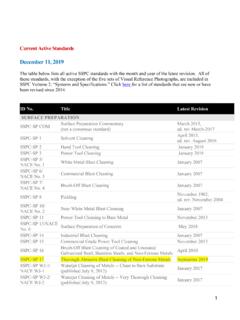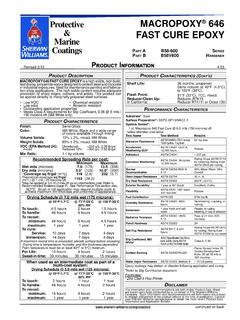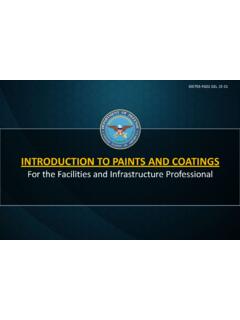Transcription of Surface Preparation Standard No. 1 - .NET Framework
1 sspc -SP 1 April 23, 2015 Editorial Revision August 10, 20161 sspc : The Society for Protective CoatingsSurface Preparation Standard No. 1 Solvent Cleaning1. This Standard defines the end-condition of a metal Surface from which visible deposits of oil, grease, and other visible contaminants have been removed in Preparation for subsequent application of protective coatings or for the use of additional methods to prepare the Surface for the application of coatings. The Standard also includes requirements for materials and procedures necessary to achieve and verify the end condition. 2. When viewed without magnification, a solvent-cleaned Surface shall be free of visible oil, grease, dust, dirt, drawing and cutting compounds, and other visible soluble contaminants. Visible means detectable with normal or corrected normal vision without the use of additional test equipment (see Note ).
2 For the purpose of this Standard , a solvent is defined as any liquid or vapor, permitted by the owner of the item being cleaned and used in compliance with all health, safety and environmental regulations applicable at the job site, that will dissolve or emulsify visible deposits of soluble contaminants on the Surface . Examples of solvents include: water, emulsion or alkaline cleaners, and hydrocarbons. 3. Surface Preparation Before and After Solvent Before solvent cleaning, remove visible foreign matter (other than grease and oil) by one or a combination of the following manual methods: brushing with stiff fiber or wire brushes, or scraping. Remove localized deposits of oil or grease by scraping. Remove the remaining visible oil or grease by any of the methods listed in Section before using additional methods of Surface Preparation or immediately prior to coating application if additional Surface Preparation is not required, the Surface shall meet requirements of Section 4.
3 Methods of Solvent Apply the solvent to the Surface by spraying or using rags or brushes wetted with approved solvent. Wipe or scrub the Surface with rags or brushes wetted with Use clean solvent and clean rags or brushes for the final rinsing or wiping. Use stabilized chlorinated hydrocarbon solvents to perform vapor Immerse completely in a tank or tanks of solvent. For the last immersion, use solvent that will not deposit residual contaminants on the Surface being cleaned. Apply emulsion or alkaline cleaners as described in Sections through After treatment, wash the Surface with Surface Preparation water2 or steam to remove visible residual contaminants. Steam clean, using detergents or cleaners and follow by steam or Surface Preparation water wash to remove visible residual contaminants.
4 5. This is a consensus Standard developed by sspc : The Society for Protective Coatings. While every precaution is taken to ensure that all information furnished in sspc standards is as accurate, complete, and useful as possible, sspc cannot assume responsibility nor incur any obligation resulting from the use of any materials, coatings, or methods specified herein, or of the specification or Standard This Standard does not attempt to address problems concerning safety associated with its use. The user of this Standard , as well as the user of all products or practices described herein, is responsible for instituting appropriate 1 Local regulations or owner restrictions may prohibit the use of certain solvents. If coating is to be applied following solvent cleaning, the coating manufacturer should be consulted for recommended solvents.
5 2 The sspc /NACE waterjetting standards ( sspc -SP WJ-1, 2, 3 and 4/NACE WJ-1, 2, 3, and 4) define Surface Preparation water (SP water) as water of sufficient purity and quality that it does not prevent the Surface being cleaned from achieving the [specified degree] of Surface cleanliness or nonvisible contamination criteria when contained in the procurement documents. sspc -SP 1 April 23, 2015 Editorial Revision August 10, 20162health and safety practices and for ensuring compliance with all governmental NotesNotes are not requirements of this Standard . Additional Verification Methods: Project specifications may require visual verification to be supplemented by methods including but not limited to the options listed below for the visual detection and verification methods defined in Section Areas subject to verification by these methods should be identified prior to solvent Wipe Test: A clean dry white rag is wiped across the [dry] cleaned area(s) and examined for visible residue.
6 Ultraviolet Light: The cleaned area(s) are examined for the presence of fluorescing hydrocarbon residues using ultraviolet Water-Break Test: The cleaned area(s) are examined in accordance with ASTM F21, Standard Test Method for Hydrophobic Surface Films by the Atomizer Test, or ASTM F22, Standard Test Method for Hydrophobic Surface Films by the Water-Break Test. Surface Dust Test: The cleaned area(s) are examined in accordance with ISO 8502-3, Preparation of steel surfaces before application of paint and related products Tests for the assessment of Surface cleanliness, Part 3: Assessment of dust on steel surfaces prepared for painting (pressure-sensitive tape method). 5 An acceptable dust class should be established prior to conducting Surface dust tests. 3 sspc TU 11, Inspection of Fluorescent Coating Systems provides guidance on inspection techniques and recommended personal protective ASTM International, 100 Barr Harbor Drive, West Conshohocken, PA 19428-2959.
7 For referenced ASTM standards, visit the ASTM website, < >. For Annual Book of ASTM Standards volume information, refer to the Standard s Document Summary page on the ASTM International Organization for Standardization (ISO), Case Postale 56, Geneva CH-1211, Switzerland. ISO standards may also be obtained through the American National Standards Institute (ANSI) at < >Copyright sspc standards, guides, and technical reports are copyrighted world-wide by sspc : The Society for Protective Coatings. Any photocopying, re-selling, or redistribution of these standards, guides, and technical reports by printed, electronic, or any other means is strictly prohibited without the express written consent of sspc : The Society of Protective Coatings and a formal licensing agreement.







